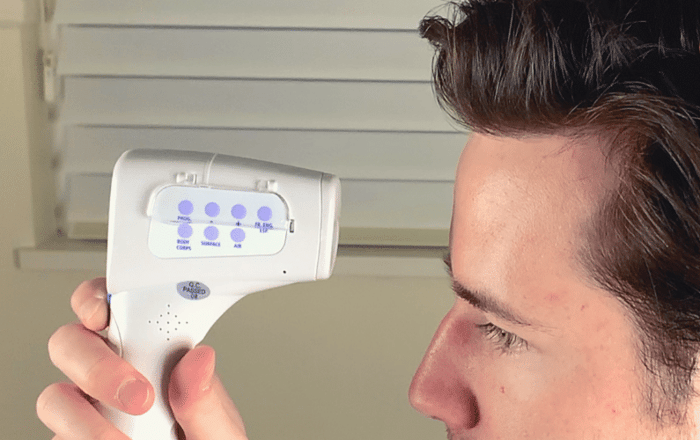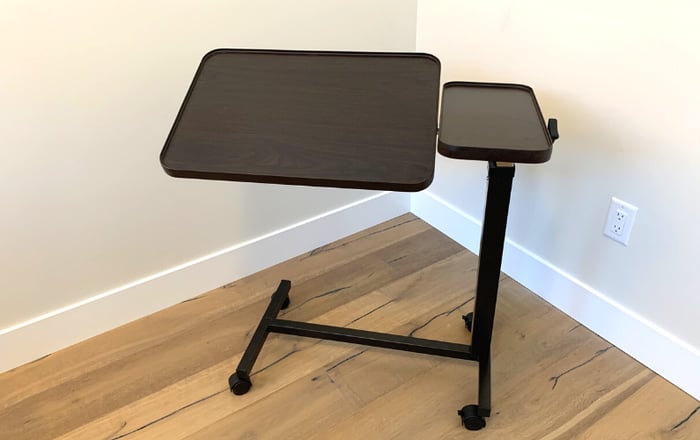eFever is commonly the body's first reaction to an illness or infection. Learn how to accurately monitor your temperature by using an infrared thermometer.
Infrared Thermometers: A Necessity for Home Healthcare
When you, your loved ones or people you care for are feeling unwell, monitoring body temperature is one of the first things you should do.
There are many methods of assessing body temperature. We often ask if they feel warm, or look to see if they have flushed cheeks and glazy eyes. Next, there's the age-old way of measuring their body temperature by placing the back of your hand on their forehead. If a temperature is suspected after observations and the forehead test, the next step is to check it with a thermometer.
Now, there are new, easier, and more accurate ways to do this. Thanks to the advances in infrared thermometer technology over the past 15 years, this whole process can now be completed within a few seconds.
Over 300 Years of Mercury Thermometer
Mercury thermometers have been a staple in medicine cabinets for hundreds of years. Traditionally these (predominantly glass) thermometers have been used as contact thermometers.
They are used by placing them under the tongue, in the armpit, or rectally and waiting up to three minutes. However, since these thermometers are made of glass, they pose a risk of breakage or leakage.
The mercury contained in these thermometers is toxic to humans and the environment, making them potentially dangerous to their user.
Many US states have banned mercury thermometers and they are not even available for sale at all in Europe. In fact, mercury thermometers have not been available for sale in the UK since 2009.
In countries where they are available for sale, manufacturers have moved towards infrared alternatives. Mercury thermometers have been steadily phased out for in home use.
Daniel Fahrenheit, who invented the mercury thermometer, provided us with over 300 years of this vital tool, but over the past 15 years, the torch has been passed.
Now, infrared thermometers provide a faster, safer, and more convenient alternative.
If you still use an old glass mercury thermometer, we suggest you stop and opt for a new infrared thermometer. Once you do that, safely dispose your old thermometer, store it carefully or merely use it as a conversation piece.

Contact and Non-Contact Infrared Thermometers
Say goodbye to old mercury thermometers and say hello to new infrared alternatives. There are two different types of infrared thermometers - contact and non-contact. Although still safe and accurate, contact thermometers require body contact, time for a temperature reading, and cleaning after each use.
Given that temperature is one of the key vital signs when assessing illness, many people opt for the convenience, timeliness, and cleanliness of non-contact infrared thermometers (NCIT). Simply aim the thermometer at the forehead of the patient and the digital temperature reading usually appears instantly or within seconds.
Consider for a moment, a large family with several people that are ill at the same time. You can not only accurately take your own temperature, but also the temperature of multiple other people in seconds.

The Best Choices for Infrared Thermometers
Only a few years ago the cost of non-contact infrared thermometers was generally so high that it was priced out of budget for most families.
Although still more expensive than contact thermometers, today, there are a number of accurate and more affordable alternatives.
At HaloHealthcare.com, we have many different models of non-contact thermometers to choose from.
HaloHealthcare.com's customer favourite for a reasonably priced infrared thermometer is the Dikang Infrared Non-Contact thermometer, followed by Dr. Ho's Infrared Touchless Thermometer and the HoMedic No Touch Infrared Thermometer.
Check out the AMG PhysioLogic Pro Scan Non-Contact Thermometer below.
All of these are awesome choices to buy for your home. They also ship quickly and qualify for free shipping.
We hope you learned everything you need to know about infrared thermometers and why you should look into picking one up for your home. If you want to keep yourself and your family safe and healthy, check out our full range of infrared thermometers here!










